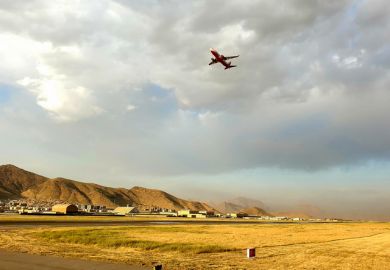These three books offer important but divergent analyses of the current food system. Gordon Conway argues that a judicious mixture of hi-tech and environmentalism could feed the world well and deliver a properly "green" food revolution. David Goodman and Michael Watts argue that agricultural markets have entered a new era of commodification and that the fancy language of globalisation is a continuation of an age-old process of political greed triumphing over need. And Stephen A. Brown charts the arrival of the now ubiquitous bar code on packaging which has allowed the astonishing logistics revolution in modern distribution to occur. Without such developments, hypermarketisation would not have happened.
Conway is an extremely experienced researcher and writer whose research on pesticides played a pioneering role in the Integrated Pest Management (IPM) movement. He has just left Sussex University, where he headed the Institute of Development Studies and was vice-chancellor, to become the first non-US president of the Rockefeller Foundation. The Doubly Green Revolution is the work of a man with his finger in many pies, no blind technocrat but a scientist with a vision of a socially just food system.
This book offers answers to the big questions: will there be enough food? who for? It starts by acknowledging that the food world is already massively fissured. One fifth of the developing world is hungry. Yet, as he reviews the various "big models" of the future provided by the UN Food and Agriculture Organisation (FAO), the International Food Policy Research Institute (IFPRI) and World Bank, Conway is left uneasy. "Market forces, the models imply, will create appropriate demand which, in turn, will stimulate the necessary technological innovation and infrastructural investment to ensure a sufficient supply of food." But since there are legions of the hungry, he notes, this cycle clearly does not happen without being made to happen.
Conway's core argument is that "hunger and poverty can be eliminated through the application of modern science and technology, provided they are used wisely and are supported by appropriate economic and social policies, and a will to act." His vision of solutions to the apparent problems requires a three-pronged approach. First, new plants and animals must be designed - using biotechnology and genetic engineering - to enable use of land that is currently marginalised. Second, environmental protection demands the application of ecological sciences to tackle pests, harness nutrients and protect soil and water. And third, new social processes are required to build genuine partnerships between scientists and those who farm the land. It is this latter point which marks out Conway among proponents of biotechnology.
The big corporations argue: "Please trust us to have another go with biotechnology; after all, we know the issues so well, so who is better suited to offer a new, softer, kinder way of farming?" Conway cannot be dismissed as a corporate fall guy. He argues that if food is to be produced for the extra billions of mouths in the 21st century, participation from below, not control from above, will be the key. At a time when food scientists have had a rather poor press, it is good to be reminded that many of them do have a social vision, but we cannot quite leave the matter there. Conway's rosy view of the first Green Revolution is one with which many might disagree. It is true that yields went up, but so did some pollution, concentration of land ownership and a flight of labour from the land. The technology may have delivered but the social and ecological costs were considerable. Clear statement of the humane vision for biotechnology though it is, The Doubly Green Revolution's real weakness lies in its failure to address the astonishing concentration of power over food systems shown by Goodman and Watts and Brown.
The Gatt and the World Trade Organisation, for example, are almost contemptuous of the kind of "bottom up" participation that Conway calls for, and having observed how transnational corporations (TNCs) operate, I am a little sceptical about the depth of their commitment to socially responsible science. Monsanto, for instance, is, as I write, planning a consumer offensive to try to restore public confidence in biotechnology, having done more than any other company world-wide to undermine it in the first place by its astonishingly high-handed approach to consumers in initially refusing to segregate its genetically modified soya from other varieties. This would be forgivable, perhaps, as an aberration were Monsanto not one of the companies that more than 30 years ago tried to diminish Rachel Carson for her critique of pesticide pollution in Silent Spring. Other major companies have persistently flouted the WHO and Unicef's international code on marketing of breast-milk substitutes.
The fact is that the first wave of products produced by biotechnology has, in my view, little to do with addressing the causes of world malnutrition. Soya or a sugar beet genetically modified to resist glyphosate are hardly hunger-beaters. They are about consolidating control over marketplaces, enabling some farmers to squeeze others out of business and generally privatising genetic material previously commonly owned. I am not alone in viewing this hijack with some concern.
Conway is more convincing in arguing that no equitable food system is possible without the participation of scientists. But on which side will science and scientists be? Good though it is to read a rational and impassioned plea for food science in decision-making, we should not underestimate the creeping effect of corporate funding of science. Too often evidence offered in defence of new food processes is commercially confidential and has either been conducted by or funded by the corporation which seeks to gain from it. Fair enough, one might argue, why not? But it is we who are going to be eating it.
This is a real political hot potato for politicians and for the globocrats in bodies like the Codex Alimentarius Commission, the UN body which the 1994 Gatt gave "influence" over setting international food standards. Yet at Codex meetings, there sit the very TNCs who already straddle the world's food trade; consumer and independent public health representation is tiny by comparison. This is why Conway's suggestion that participation should be in the open is so important. Too often, participation is a code word for allowing participation at the local level, the process we have called "glocalisation". In a world where policy is made globally (and not just in food policy), token localism looks dangerously like a side-show. Policymakers please note.
Political naivety is not a criticism that can be levelled at the Goodman and Watts collection, Globalising Food. This is a compilation of chapters based on a US seminar on the restructuring of the agro-food system, ie the globalisation question. I approached the book with considerable deference. Goodman, formerly at University College London, now at the University of California, is co-author of one of the great texts in this area, Refashioning Nature, with Michael Redclift, who also writes a masterly essay here. This new book is a fascinating insight into current work by some excellent thinkers and researchers. The subjects range from chicken farming and cotton to bureaucrats and lawyers, from the Caribbean and Venezuela to Iowa and the UK.
The book is ordered into sections which seem a bit arbitrary. I missed its internal logic and preferred to read it as a patchwork essay on the complexities of globalisation. The joy of the book, expressed by nearly every author, lies in its scepticism about the neo-liberal view of globalisation used by too many politicians when urging us to run harder on the treadmill of global competitiveness. Reading about the new markets for intensive chicken factories or the volatility of the cotton trade as it affects farmers, provides a useful antidote to that ideological hogwash. The essays by William Boyd and Watts on the US chicken industry and by Terry Marsden on regulation of markets, are particularly useful. Drawing on empirical work in Brazil, the Caribbean and the UK, Marsden argues that rural space is being redrawn and interconnected by a variety of means: national and international regulation, retailer dominance, use of new technologies. Boyd and Watts show how intensification has enabled the US to stop being a nation of beef eaters to become one consuming more chicken. This trend was driven not by health but cheap labour in the US South.
Globalising Food is particularly useful for the theoretical analysis Watts and Goodman provide. Like a Greek chorus, they keep popping up to provide a commentary and to remind us what the book is about. Their starting point is not a fashionable postmodernist but Karl Kautsky, author of The Agrarian Question. A century apart, both books ask: why is it that agriculture and food are becoming so politically important when their economic weight is declining? Then, as now, agriculture was intensifying and was driven by competition and market integration. Then, too, agricultural change was determined by forces off the land rather than on it.
These are useful reminders. When in March this year, 250,000 marchers clamoured for defence of the countryside (around a core of support for fox-hunting), one regrets that the government did not just call their bluff; after all, urban taxpayers massively subsidise the country today. Today, the driving force of the food economy is no longer the farmer, but the retailer. As Goodman and Watts remind us, the key notion is value-adding. Cornering a market in sales is more profitable than growing the primary commodity, which is why in the period 1974-90, the top 100 global agro-industrial corporations increased their ownership of affiliates from 2,000 to more than 5,000 companies, accelerating sales value from $121 billion to $517 billion in the same period. As Richard Barnet and John Cavanagh in their seminal Global Dreams: Imperial Corporations and the New World Order (1996) argued, these already big food companies are having to intensify their sales by purchasing companies in new markets because their home sectors are so often already highly concentrated.
Globalising Food is a significant contribution to a new radical critique of globalisation that is, thankfully, emerging after the years of glorification. It highlights the complexity of the process of change as borders come down and helps us all, whether interested in food or not, to make a more sober assessment of the extraordinary concentration of power within the new era.
Revolution at the Checkout Counter is an absolute must for both business and food watchers. It deserves to be a classic. Stephen A. Brown, a Virginia attorney, was himself part of the plot, legally advising the pioneering grocery executives, many of whom he sketches. The tale he tells is riveting. He plots the people and companies who believed 30 years ago that there might be a value in having a universal product code to help data processing in the food trade. In just two years, 1971-73, an ad hoc committee of ten executives took the embryonic technology and pushed it through the industry, setting up a process of classic technology dissemination and advantage. Today, barely a product lacks a bar code and its use has spread far beyond the food trade. Only last week, there was a knock on my door at work and in walked a team to bar code every bit of equipment in the office; I only just rescued some of my own goods from being annexed by the university. Once in the databank, never out.
The extent of bar-code take-up was not envisaged by the pioneers, and the scheme almost foundered on tensions between manufacturers and retailers; the former loved it but the latter were more cautious. Yet it was the latter who have benefited above all. It was and is a managerialist technology, designed to increase control. An early test convinced the sceptics; productivity gains of 44 per cent could be achieved at a supermarket checkout.
If the supermarket revolution itself utilised the unpaid labour of the customer to replace the grocer's assistant, the bar code enabled retailers to keep less stock and to get the remaining labour to work more productively and, if necessary, harder. As the laser light flashes acknowledgement that the customer has purchased a product, a repeat order is on its way to the supplier. Responsibility for warehousing is passed back to suppliers and the motorway becomes the warehouse. This is a wonderful book, telling an astonishing story clearly. With the bar code, informatics came of age. Even the introduction by two Harvard Business School academics is a gem.
Tim Lang is professor of food policy, Thames Valley University.
Globalising Food: Agrarian Questions and Global Restructuring
Editor - David Goodman and Michael J. Watts
ISBN - 0 415 16253 X and 16252 1
Publisher - Routledge
Price - £50.00 and £16.99
Pages - 383
Register to continue
Why register?
- Registration is free and only takes a moment
- Once registered, you can read 3 articles a month
- Sign up for our newsletter
Subscribe
Or subscribe for unlimited access to:
- Unlimited access to news, views, insights & reviews
- Digital editions
- Digital access to THE’s university and college rankings analysis
Already registered or a current subscriber?



